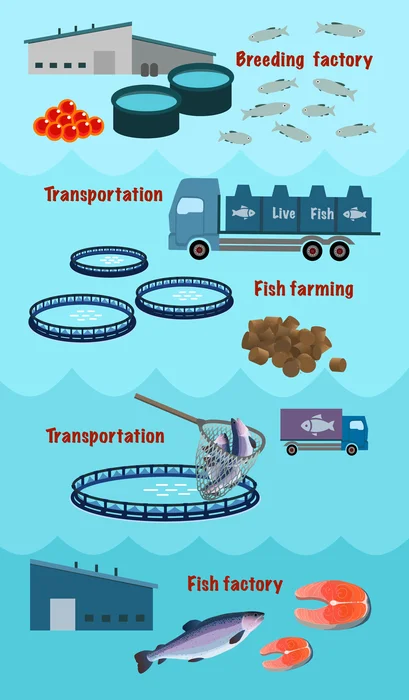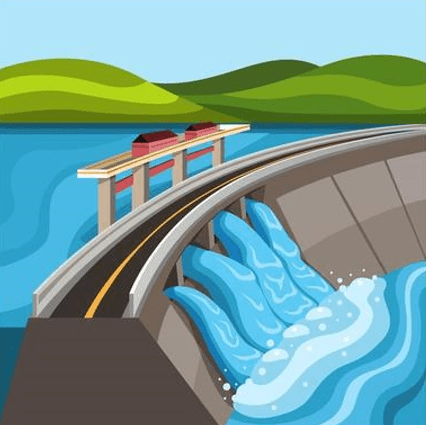Introduction
Fish was one of the easily accessible foods that humans in the past often consumed. All around the world, several fish species are consumed as food. It is a significant food that is rich in many nutrients. Different fish, whether freshwater or marine, are used by humans as food. Fish and other sea creatures that are eaten for food are more commonly referred to as seafood.
Fish as food
- Nearly half of the fish consumed today was raised through fish farming, which is practized globally.
- In aquaculture, fish such as tuna, salmon, halibut, cod, and trout are regularly farmed.
- Aquafarms can be constructed as mesh cages submerged in water in addition to concrete enclosures on land.
- Fish farms, however, have the potential to damage the ecology by introducing diseases, pollutants, and invasive species.
- In the coastal parts of India, fish is a common diet.
- Up until 1961, the annual increase in fish consumption worldwide was roughly 3.2% and it has exceeded both the size of the population and the demand for meat of terrestrial animals .
- In addition to increased production, the expansion in consumption has also been influenced by a number of other factors such as-less waste, better use, improved distribution systems, and rising consumer demand.
Fish production
- Fish production, which is known as mariculture or aquaculture where a number of fish are raised and expanded for commercial purposes. Fish can be produced using a number of techniques:
- Fishing capturing: As the name implies, fish in this are collected from many water bodies such as ponds, lakes, rivers etc.
- Fish breeding: It is the practise of raising particular fish species in confined water bodies with great care to achieve optimal yield. This is often referred to as pisciculture or fish farming. It is divided into two further categories:
- Inland fishery– Fishing in fresh waterbodies such rivers, ponds, lakes, etc. is referred to as inland fishery. The production in this is average. Examples of fishes grown are Rohu, Catla, carp, etc.
- Marine fishery– The majority of marine fisheries include fishing in sea and ocean water. Offshore and deep-water fisheries are the two main categories of marine fishery. Fishes grown here are Pomfret, sardines, hilsa,etc.
- Additionally, there are three different approaches to fish farming: extensive, semi-intensive, and intensive.
- Extensive fish farming– In extensive fish farming, fish productivity is based on the natural productivity of water, it requires large ponds with minimal care.
- Semi-intensive farming– This method uses fertilisers to boost the natural productivity of fishes. It has relatively small ponds with a higher fish density.
- Intensive farming- An extremely well-maintained and well- controlled method of raising fish, in small ponds and tanks, is known as intensive farming.

Making of Regional Cultures
People eat what is easily accessible to them in a particular place. For instance, rice and fish are the two main staple foods of Bengal, which has hot and arid climate. Numerous instances may be found in the literature, sculptures, and artwork of the Bengali people that demonstrate how important fishing has always been to their culture. For instance, the walls of temples and viharas sometimes have ceramic plaques showing scenes of fish being prepared and transported to markets in baskets. Since fish is a common cuisine in Bengal, Brahmins were allowed to eat some varieties of fish even if their religion forbids doing so. This was found in a text from the thirteenth century called the Brihaddharma Purana. All of these demonstrate how the regional culture of Bengal developed, due to fish and how eating fish did not become a matter of debate there.
Summary
The consumption of fish as a staple food became common practice since it was easily available. People started using different techniques to capture and breed fish. In general, there are two types of fisheries- inland fisheries where fish are caught from fresh water, and marine fisheries salt where fish are caught from seas and oceans. A number of variables, including decreased waste and rising consumer demand, contributed to the increase in fishing productivity.
Frequently Asked Questions
1. Why is fish considered a healthy food?
Ans: One of the world’s healthiest foods is fish because it has important nutrients like protein and vitamin D in abundance. Also, omega-3 fatty acids, which are vital for your body and brain, are also found in fish.
2. Which fish has high protein content?
Ans: Fresh tuna contains the greatest protein per gram. It is the most commercially available and provides the greatest protein per weight (30.7g in a 100-gram serving).
3. Is fish more nutritious than meat?
Ans: Red meats (beef, hog, and lamb) often contain higher cholesterol and saturated (bad) fat than chicken, fish, and plant-based proteins like beans. Saturated fat and cholesterol can increase blood cholesterol levels and aggravate heart disease. Hence as compared to red meat, chicken and fish have less saturated fat and are more healthier.

